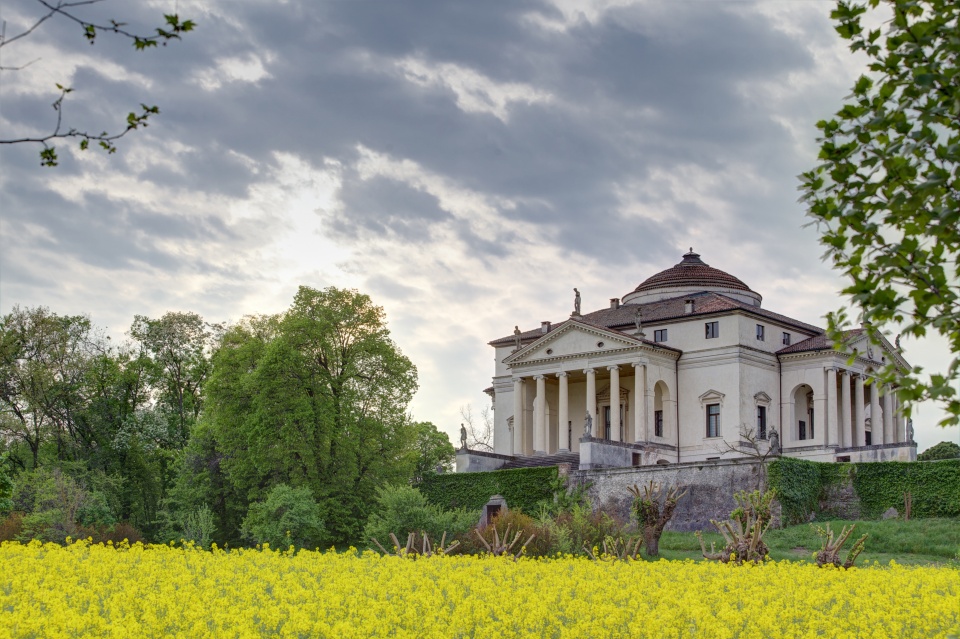
Andrea Palladio is probably the most influential of all architects, its success and heritage – Palladianism - spanning over more than five hundred years and covering almost all continents. In 2010, the 111° Congress of United States of America nominated Palladio “Father of American Architecture” recognizing that “large part of architectural monuments in the USA, directly or indirectly inspired by Palladio’s writings and projects, form a large and invaluable part of the cultural heritage of the Nation”. That’s a big achievement considering that Palladio, born in Padua on 30 November 1508, as Andrea di Pietro della Gondola, spent his entire life in Veneto, and significantly in Vicenza.
To the fast visitors Vicenza might be just a train stop between superstars Venice and Verona. Yet, this small city, a barely 40 miles north-west of the Veneto region’s capital has been appointed on the map of UNESCO Heritage List since 1994 as the City of Palladio, and rightly so: Vicenza historical, medieval centre is a casket of architectural jewels, among them are 23 masterpieces, conceived and built by Andrea Palladio during the 16th century.
In Vicenza Palladio’s talent was exercised on designing and building private townhouses as well re-designing existing ones or public spaces such as the municipal town hall, which Palladio himself renamed “Basilica”. The favour and support of Gian Giorgio Trissino, Palladio’s mentor and first client, and of the rich Vicentine families, gave to the emerging architect the opportunity to transform and renovate the urban texture with splendid palazzi, a unique appearance which the city still retain intact.

Later in his life, in 1570, Palladio became the official architect of the Serenissima Republic and, while in Venice he expressed his enormous genius mostly on religious buildings, although he also had projects for public spaces such as the Rialto bridge and the restoration of Palazzo Ducale.
And yet it is in the Veneto countryside that we find the maximum expression of Palladio's talent with the numerous country-houses, the "casa di villa", built mostly for the Venetian aristocrats. The villas are a summa of balance and elegance, a love dialogue between humanity and nature, Palladio’s ultimate search for beauty and peace.
Trissino took Palladio on a number of trips to Rome to study ancient architecture and introduced him to the study of Latin and to Vitruvius's summa on classic architecture, De Architectura. Palladio adopted Vitruvius architecture fundamentals, firmitas, utilitas, venustas (strength, utility and beauty) and went further implementing his own principles and a working method, which ultimately became the “Four Books of Architecture”, probably the most famous aarchitecture manual, an ante-litteram best seller, which spread the seeds of Palladio enormous popularity in the following centuries. 500+ years after is still on sale on Amazon!


Palladio’s method was quite simple: first, understand client’s demands (the commissioner’s desires and personal taste). Second, study in deep the location (the horizon and the views, the garden, the ambience). Third, never underestimate the practical aspects (the damned mosquitos, the water supply, the best plants and, in the end, the budget).
So, while he designs elegant palaces, facades with clear proportions, villas with classic entrances, a columned portico, he is also concerned with solving the problem of water supply, the stench of cows, the protection of assets from thieves and so on.
In Bassano del Grappa, faced with a bridge too often destroyed by the common flooding, he was the first to conceive a wooden bridge, apparently way more fragile compared to a solid stone structure, yet so flexible to be able to resist to the worst river surge. Memorable and amusing, is the explanation of the need for long corridors in lawyers' homes: when you go to see a lawyer you are always nervous, so according to Palladio you need space in which to let off steam by walking back and forth. What a wise man!

Dealing with Venetian aristocrats whose wealth had been built on marine trade, he learned to negotiate a budget and respect it. Building materials were sourced locally and mostly low-cost: ashlar for the basements, bricks and terracotta for walls, columns, pediments and interiors, but plastered and frescoed as if it was precious pink, white or green marble.
Even the flooring of most villas is made of an original, inexpensive technique invented by Palladio: marble flakes and stone slabs of various types and color, always in small sizes, residual products of other workings, are set in a cement bed, the joints then sealed with a white or pigment-colored grout, depending on the design. The surface then is made even with a roller and after the floor hardens, it is sanded and wax-polished, which brings out the brilliant colors and pattern. This kind of flooring, still in use, bear the name of its inventor thus we call it Palladiana.
Palladio was the first architect to integrate classical porticos into domestic housebuilding. Until then they had really only been used on religious buildings. "Palladio reinvented the architecture of antiquity for contemporary use," and “introduced the concept that Roman architecture could be adapted to benefit all social classes," according to Charles Hind in his “Palladio and His Legacy: A Transatlantic Journey”.
For Thomas Jefferson, Palladio’s Four Books were the bible: the Palladian architecture’s visuals of balance and beauty, united with a handy pragmatism were all that Jefferson needed to shape the face of the new Nation through its public and private spaces, from the White House to the Congress, from its own private country house, Monticello, to the University of Virginia.
The exceptional elegance of Palladian buildings based on simplicity, even austere, and compositional serenity is based on the use of mathematical proportions and classic language. This result is enhanced in many of Palladio’s works by the use of an imposing portico, which had also the practical advantage to allow owners and visitor to gather, relax and admire the landscape, while remaining protected from the sun or the rain.
The Palladian portico has influenced more any than any other the American housing lifestyle as it evolved in the widespread use of front porches in American houses, from the sumptuous Southern mansions to the rustic Western lodges. A status symbol, a place for the family to gather before the TV room was invented, an idyllic space where to relax, gaze the horizon, commune with nature … If “front porches are as American as apple pie, and the history of the American front porch is in some ways the history of the American people as well”, then a bit of that history has been shaped by Andrea di Pietro della Gondola, from Vicenza.
